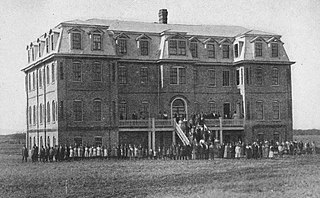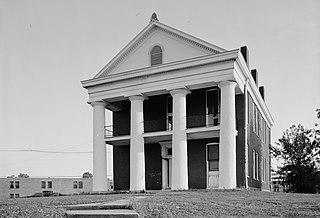
Alcorn State University is a public historically black land-grant university adjacent to Lorman, Mississippi. It was founded in 1871 and was the first black land grant college established in the United States. The university is a member-school of the Thurgood Marshall College Fund.

Western College for Women, known at other times as Western Female Seminary, The Western and simply Western College, was a women's and later coed liberal arts college in Oxford, Ohio, between 1855 and 1974. Initially a seminary, it was the host of orientation sessions for the Freedom Summer in 1964. It was absorbed by Miami University in 1974 after dwindling finances. Now known as the Western Campus of Miami University, it was designated a U.S. Historic district known as the Western Female Seminary Historic District in 1979.

The California School for the Blind is a public educational institution for blind children, K-12, located in Fremont, California. Its campus is located next to the California School for the Deaf.

Oakland Memorial Chapel is a historic church and academic building on the campus of Alcorn State University in rural southwestern Claiborne County, Mississippi. Built in 1838 as part of Oakland College, it is one of the oldest surviving buildings at Alcorn State, which took over that defunct school's campus after the American Civil War. Alcorn State was the first land grant university established specifically for the education of African Americans. The chapel was designated a National Historic Landmark in 1976, and was designated a Mississippi Landmark in 1985.
This is an incomplete list of historic properties and districts at United States colleges and universities that are listed on the National Register of Historic Places (NRHP). This includes National Historic Landmarks (NHLs) and other National Register of Historic Places listings. It includes listings at current and former educational institutions.

Saint Mary's School is a private independent Episcopal college-preparatory, boarding and day school for girls in grades 9–12. Located in Raleigh, North Carolina, Saint Mary's School operates as an independent school with a historic association with the Episcopal Church including an Episcopal chapel, St. Mary's Chapel, on the school's grounds. The school formerly operated as Saint Mary's College and for many decades educated young women in grades 11–12 and their freshman and sophomore years in college. The school changed to a four year high school in 1998, at which point the name reverted to Saint Mary's School, the original name of the institution when it was founded in 1842.

Chamberlain-Hunt Academy was a boarding school in Port Gibson, Mississippi. The school was founded in 1830 as Oakland College and closed in 2014.
A Mississippi Landmark is a building officially nominated by the Mississippi Department of Archives and History and approved by each county's chancery clerk. The Mississippi Landmark designation is the highest form of recognition bestowed on properties by the state of Mississippi, and designated properties are protected from changes that may alter the property's historic character. Currently there are 890 designated landmarks in the state. Mississippi Landmarks are spread out between eighty-one of Mississippi's eighty-two counties; only Issaquena County has no such landmarks.

Deveaux School Historic District is a national historic district located at Niagara Falls in Niagara County, New York.

The Gorgas–Manly Historic District is a historic district that includes 12 acres (4.9 ha) and eight buildings on the campus of the University of Alabama in Tuscaloosa, Alabama. The buildings represent the university campus as it existed from the establishment of the institution through to the late 19th century. Two buildings included in the district, Gorgas House and the Little Round House, are among only seven structures to have survived the burning of the campus by the Union Army, under the command of Brigadier General John T. Croxton, on April 4, 1865. The other survivors were the President's Mansion and the Old Observatory, plus a few faculty residences.

Richardson Hall, also known as College Building and Main Hall, is a historic institutional building at St. Lawrence University, Canton, in St. Lawrence County, New York. It is a three-story rectangular brick structure built on a high sandstone foundation. When constructed in 1855–1856, it housed the dining room, chapel, classrooms, and dormitory space. It was renovated in 1906 and 1962. It is located within the St. Lawrence University-Old Campus Historic District.

Shaw Hall is a historic dormitory located on the campus of West Liberty University at West Liberty, Ohio County, West Virginia. It was built in 1919–1920, and is a three-story red brick building in the Classical Revival style. The front and end facades are dominated by two-story porticos with Ionic order columns having a stucco shaft. It was built as the first dormitory on campus and housed female students. It is the oldest building on the campus of West Liberty University. The building now houses classrooms and administrative offices. The building is named for John C. Shaw, president of West Liberty Normal School from 1908 to 1919.

Farmers' High School is a national historic district located on the campus of the Pennsylvania State University in University Park / State College, Centre County, Pennsylvania. The district includes 37 contributing buildings and 1 contributing object in the Old Campus area of Penn State. The district includes Old Main (1930), the Faculty Club (1976), Nittany Lion Inn (1930), Recreation Hall (1928), West Halls Complex (1922-1937), University Club (1916), the President's Mansion, Pattee Library (1938), Schwab Auditorium (1902), and a number of fraternities, sororities, and classroom buildings. The buildings reflect a number of popular early-20th-century architectural styles including Colonial Revival, Classical Revival, and Georgian Revival. A focal point of the district is the Nittany Lion Shrine (1942).

The Baldwin-Wallace College South Campus Historic District is an area of land on the south end of the Baldwin Wallace University campus. When the district was established, the school was Baldwin-Wallace College. BW is a four-year private, coeducation, liberal arts college in Berea, Ohio, United States. The school was founded in 1845 as Baldwin Institute by Methodists settlers. Eventually the school merged with nearby German Wallace College in 1913 to become Baldwin-Wallace College, which adopted the present name in 2012. Several buildings since its founding have been established on the National Register of Historic Places, establishing this area as the Baldwin-Wallace College South Campus Historic District.

Okolona College, also known as Okolona Industrial School, and Okolona Normal & Industrial School, was a college for African Americans in Okolona, Mississippi, Chickasaw County, Mississippi. It was added to the National Register of Historic Places on August 9, 2002. The school is located on Mississippi Highway 245 1.1 miles north of the junction with Mississippi Highway 32 and Mississippi Highway 41. It is part of The Okolona College Historic District.

Winthrop College Historic District is a national historic district located on the campus of Winthrop University at Rock Hill, South Carolina. It encompasses 17 contributing buildings and 1 contributing structure constructed between 1894 and 1943. Architectural styles represented include Gothic Revival, Richardsonian Romanesque, Classical Revival, and Colonial Revival. Notable buildings include the separately listed Tillman Hall and Withers Building, as well as Alumni House, Phelps Dormitory, Thurmond Building, Byrnes Auditorium, Johnson Hall, and the President's Residence.

Oakland College was a private college near Rodney, Mississippi. Founded by Dr. Jeremiah Chamberlain in 1830, the school was affiliated with the Presbyterian Church. It closed during Reconstruction, and some of its former campus is now part of the Alcorn State University Historic District.

Chapel Hill Historic District is a national historic district located at Chapel Hill, Orange County, North Carolina. The district encompasses 46 contributing buildings, 2 contributing structures, and 2 contributing objects on the central campus of the University of North Carolina at Chapel Hill and surrounding residential sections of Chapel Hill. The district's buildings date from 1795 to the early-20th century and include notable examples of Classical Revival and Jacobean Revival architecture. Located in the district and separately listed are the Chapel of the Cross, Old East, building and Playmakers Theatre. Other notable contributing resources are the Davie Poplar, Old West (1822), South Building (1798), the Old Well, Person Hall (1797), Gerrard Hall (1822), New East, New West, the Joseph Caldwell Monument (1858), the Y.M.C.A. Building, Battle-Vance-Pettigre11 Dormitory (1913), Horace Williams House (1854), the Phillips Law Office, the Phillips House (1856), the Old Methodist Church (1853), Senlac, Hippol Castle (1920s), and Battle Park.

George Awsumb was a prominent Norwegian-American architect in the first half of the 20th century. Awsumb defined architecture as “frozen music” designed for the “man on the street.” He was influenced by his early life, European travels, and prevailing architectural trends of his time. His eclectic, progressive portfolio included neoclassical, Gothic Revival, Prairie School, and International Style designs. Several buildings that Awsumb designed have been in continuous use in the American Midwest and South for over 100 years. In particular, Awsumb began a family architectural legacy that contributed to the progress and development of Memphis, Tennessee.


















